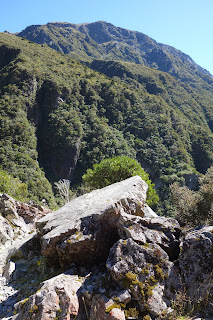Can you find the faces in the rocks?
At the town of Arthur's Pass, we devoured our delicious lunch before beginning our hour hike to Devils Punchbowl waterfall. This was the shortest and easiest of the many hikes we did in New Zealand and the 131 meter waterfall was impressive.
Ten minutes past Arthur's Pass we stopped at the Otira viaduct lookout. We had been informed that this was a good place to spot a Kea - the large and pesky New Zealand parrot. In addition to seeing some beautiful views, we were able to track down the greenish colored bird.
According to the NZ government website, "the Pancake Rocks that Punakaiki is famous for, are limestone formations that began forming 30 million years ago, when lime-rich fragments of dead marine creatures were deposited on the seabed, then overlaid by weaker layers of soft mud and clay. The seabed was raised above sea level by earthquakes to form the coastal cliffs and coastline. The sea, wind and rain have since etched out the soft layers to form the unusual rock formations we see today. When conditions are right, heavy ocean swells thunder into the caverns beneath the rocks and huge water spouts blast skywards through the blowholes in a truly spectacular sight." We didn't see any blowholes in action, but the rocks formations were enough to satisfy this tourist.
We concluded our day with a nice seafood dinner at a restaurant in Greymouth near our hotel.






















































No comments:
Post a Comment